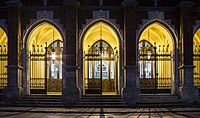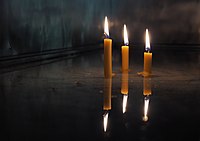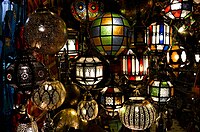Solid-state lighting
This article relies largely or entirely on a single source. (June 2012) |
Solid-state lighting (SSL) is a type of
The typically small mass of a solid-state electronic lighting device provides for greater resistance to shock and vibration compared to brittle glass tubes/bulbs and long, thin filament wires. They also eliminate filament evaporation, potentially increasing the life span of the illumination device.
Solid-state lighting is often used in traffic lights and is also used in modern vehicle lights, street and parking lot lights, train marker lights, building exteriors, remote controls etc.[1] Controlling the light emission of LEDs may be done most effectively by using the principles of nonimaging optics.[2] Solid-state lighting has made significant advances in industry. In the entertainment lighting industry, standard incandescent tungsten-halogen lamps are being replaced by solid-state lighting fixtures.[3]
See also
- L Prize
- LED lamp
- List of light sources
- Smart lighting
References
- ^ California Sustainability Alliance Solid State Lighting, Received July 24th, 2010
- ISBN 978-1482206739.
- ^ Kho, Mu-Jeong, Javed, T., Mark, R., Maier, E., and David, C. (2008) 'Final Report: OLED Solid State Lighting: Kodak European Research' MOTI (Management of Technology and Innovation) Project, Judge Business School of the University of Cambridge and Kodak European Research, Final Report presented on 4 March 2008 at Kodak European Research at Cambridge Science Park, Cambridge, UK, pages 1-12
Further reading
- Assessment of Advanced Solid State Lighting. National Academies Press. 2013. ISBN 978-0-309-27011-3.
- Kho, Mu-Jeong, Javed, T., Mark, R., Maier, E., and David, C. (2008) 'Final Report: OLED Solid State Lighting: Kodak European Research' MOTI (Management of Technology and Innovation) Project, Judge Business School of the University of Cambridge and Kodak European Research, Final Report presented on 4 March 2008 at Kodak European Research at Cambridge Science Park, Cambridge, UK, pages 1–12.
External links
- EUROPEAN METROLOGY RESEARCH PROJECT - METROLOGY FOR SOLID STATE LIGHTING
- Solid State Lighting, International Energy Agency research project
- DOE SSL roadmap
- Lighting Research Center - Solid-State Lighting Program
- OLLA: finished European academic-industrial research project into OLED lighting
- OLED100.EU: successor to the OLLA project



